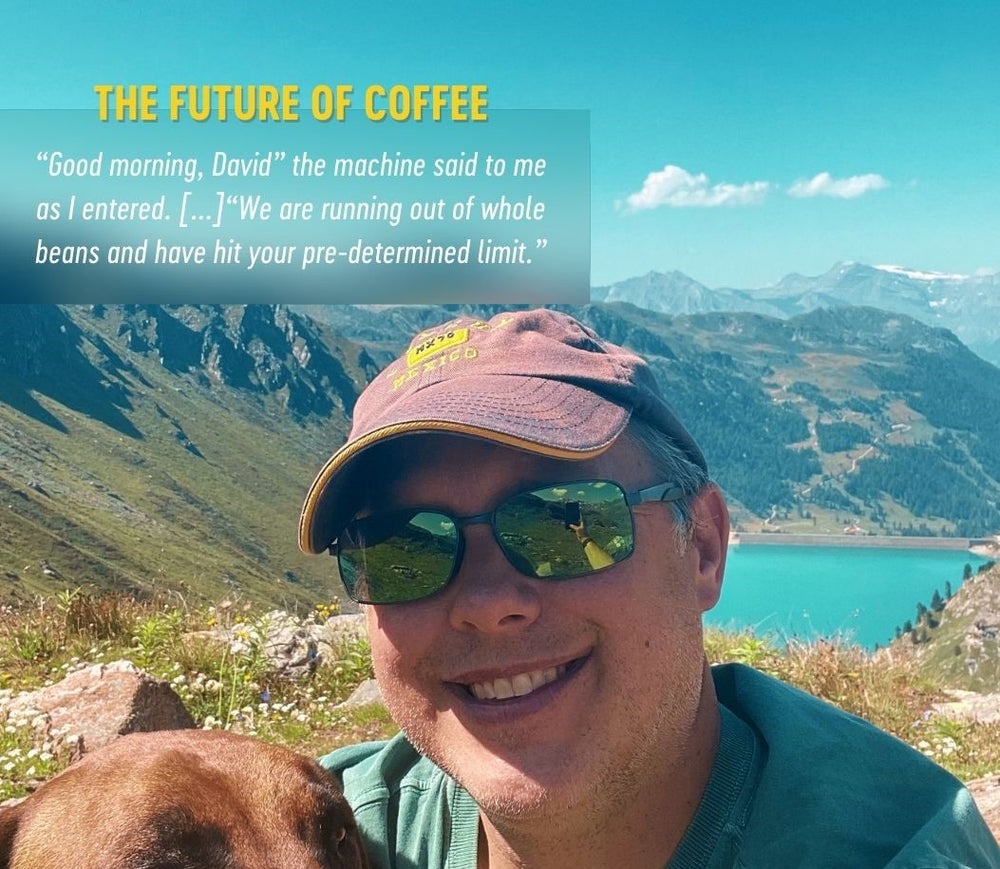News, All the Rest
Monday, December 20, 2021
What Will the Future of Coffee Look Like?
As we come to the close of 2021, we’re thinking ahead: what will the coffee supply chain look like in 10 years? Managing Partner & Head of Trading, Dave Behrends, explores this question with a short story envisioning what the supply chain will look like in 2031.

My eyes slowly flickered open, sunshine filling the room. I had quit using an alarm clock and found the natural light provided from the laser diode light bulbs a more comforting way of waking up. It was almost like being back on the farm in Kansas on a summer morning.
The sound of my “New Music Friday” algorithm playlist filled the speakers. Just over the music, I could hear the coffee grinder starting its daily ritual, prepping my favorite performance enhancing beverage. I guess my BPM had broken 70 and it was after 6am, triggering the whole process.
I stumbled out of bed, maneuvered around the sleeping Rhodesian, and headed to the kitchen.
“Good morning, David” the machine said to me as I entered.
“Mornin’ Alexa, what’s up”.
I always enjoyed the brief conversations with her while I waited for my coffee to cool off a bit.
“We are running out of whole beans and have hit your pre-determined limit. Would you like me to order more of the same Colombian Geisha.”?
This got my attention. I tended to take my coffee drinking seriously. I tried to focus. It was hard to do without my first cup.
“You know, no, let’s actually try to find something different this time. Any suggestions”?
“David, basis your preferred taste profile, I see on the marketplace offerings from Ethiopia, Rwanda, Sierra Leone and China. They all have the blackcurrant and honey notes that you enjoy”.
I thought about my Peace Corps days travelling around Africa and how much I had wanted to go to Sierra Leone but had just run out of time and money too quickly.
“Thanks Alexa, I don’t ever recall drinking coffee from Sierra Leone.”
“I can confirm from your order history that you have never had it before”.
“Interesting. Alexa, can you dig into the description and tell me a bit more about that one”?
“Of course. I see that the coffee is from the Stenophylla variety and is produced by a group of 106 farmer families located in the Moyumba region. It is rated 86 points and has perhaps a bit less acidity than you normally drink. It is fully organic, carbon and water neutral, traceable and the price you pay ensures the families earn over a 25% return on their farm.”
“Sounds right up my alley”.
“I agree, and one more thing I think you might like. There is an add-on where you can contribute an extra $1 per pack, and they will plant and name a tree in your honor”.
Better than a star, I thought to myself. We had come a long way since COP21 (the 2015 United Nations Climate Change Conference that set climate change mediation goals), but obviously there was still a lot more to be done before the planet would truly be stabilized.
“That’s great, but can we trust that what they are saying is true”, I asked.
Alexa laughed gently at me…one of her more endearing qualities, for a machine that is.
“Yes David, the coffee has both physical and digital traceability, tracking it’s DNA back to the farms and showing the complete record of custody all the way to your cup. The trees all have remote sensors with GPS location enabled so you can track baby David’s growth, via satellite imagery, during its life cycle”.
“Ok, ok, let’s go with that. Thanks Alexa”.
It wasn’t always like this. I still remember those days when I would physically go into a supermarket or to a coffee shop and compare packages side by side. The coffee usually said things like “100% Arabica” or “Gourmet Coffee”, but rarely offered more details.
In those days, if food didn’t show its ingredients, nobody would purchase it. Yet somehow, it was fully acceptable to not offer any traceability or price transparency for the coffee I drank. There was no interaction with farmers. No updates on how my consumption had impacted the planet or the humans that grew it. I had always wanted to do more as a coffee connoisseur but lacked an outlet. Worst, sometimes I even ran out of coffee and had to skip my favorite daily ritual. Oh, how I don’t miss those days!
Just then the sensor on my Bodden® ceramic cup beeped three times, letting me know that its precious contents had hit my optimal temperature for drinking.
I took a big gulp, savoring the sweetness in my mouth and could already feel my dopamine levels rising. Today was going to be a good day.
Dave’s short story offers a potential future for the coffee industry. We think the future of coffee will be more sustainable, more traceable and ultimately, better for the farmer, roaster and consumer. We’d love to hear what you think the future will look like. Contact us to share your ideas and expectations about the future of coffee.
David Behrends has over twenty years of experience working in the coffee industry, working for several multinational corporations before joining Sucafina in 2015 as Managing Partner and Head of Trading and founding Farmer Connect in 2019. Prior to working in coffee, he served as a Small Business Development volunteer in Bolivia with the Peace Corps and for an energy start-up company in Argentina. David is a passionate believer that technology will be a key driver in the evolution of agriculture supply chains in the coming decade. He is the proud father of a nine year old girl and enjoys live music and street art in his (rare) free time.